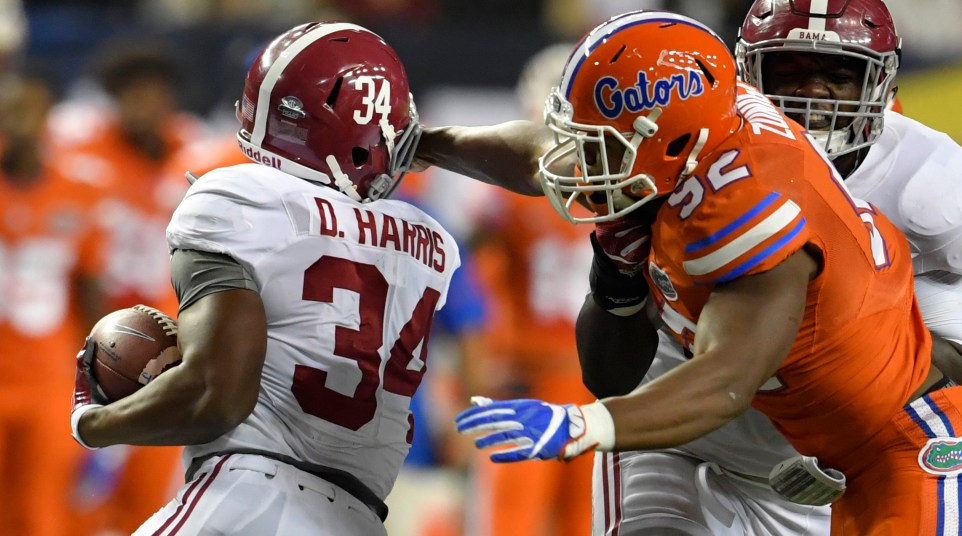
Ranking the SEC East defenses for 2017
In our latest burst of spring cleaning, we’re looking back to 2016 … and then ahead to 2017. We’re breaking down the SEC East’s defenses, looking at where they finished, whether they’ll improve or fall back in 2017, and then ranking them 1-7. Here’s how it all looks from here:
1. Florida
2016 points allowed: 16.8 points per game, third in SEC.
Better or worse in 2017? Worse, but still the best in the East.
Florida’s defense in 2016 was a historic level of excellent. Sure, it ended up third in the SEC in scoring defense (second in yardage allowed at just 293 per game). But that was a function of playing with a putrid offense (last in SEC in offensive yardage per game, 12th in scoring) and not anything the defense did. Not only did Florida allow the fewest passing yards per game in the league, but they held opposing passers to 45.1 percent completions and picked off 16 passes while allowing just eight touchdowns.
The only bad news for Florida is that the Gators do lose a lot — CBs Teez Tabor and Quincy Wilson, S Marcus Maye, LBs Alex Anzalone and Jarrad Davis, and DL Caleb Brantley. But even if Florida’s defense falls off a bit — allowing, say, 18 points and 320 yards per game — if it could be coupled with a competent offense, Florida would be almost certain to win the East again.
2. Georgia
2016 points allowed: 24.0 points per game, tied for 5th in SEC.
Better or worse in 2017? Better.
Kirby Smart preaches defense, and at times, his 2016 Bulldogs seemed to get the message. Georgia was fourth in the league in yardage allowed, giving up just 327.5 yards per game. The Bulldogs were second to Florida in pass defense, and actually topped the Gators to finish fourth in the SEC in rushing yardage allowed. Georgia’s defensive domination of an impressive Auburn offense showed what it can do.
And unlike Florida, the Bulldogs aren’t hurt too much by attrition. With guys like LB Lorenzo Carter and S Dominick Sanders (below) returning, UGA is a solid second-best defense in the East. Combine that with an offense with weapons like Jacob Eason, Nick Chubb and Sony Michel, and it’s not hard to see why UGA will be the preseason favorite to win the East (if not the entire league).

Credit: Kim Klement-USA TODAY Sports
3. South Carolina
2016 points allowed: 26.5 points per game, 8th in SEC
Better or worse in 2017? Better.
Carolina allowed 27.5 and 30.4 points per game in its previous two seasons, yielding 433 and 430 yards allowed per game. In 2016, first-year coach Will Muschamp trimmed those numbers to 26.5 points and 412 yards per game. Carolina was fourth in the East in most defensive categories in 2016.
Given the talent that Muschamp is recruiting to Columbia, it’s safe to expect improvement to continue. Muschamp could bring USC in under 25 points and 400 yards per game in 2017, and that sort of improvement would result in another bowl appearance for Carolina.
4. Vanderbilt
2016 points allowed: 24.0 points per game, tied for 5th in SEC.
Better or worse in 2017? Worse.
Vandy had an underrated defense going into the 2016 season. The Commodores ended up in the top half of the league in scoring defense, yardage allowed, and rushing yardage allowed. That said, all-everything LB Zach Cunningham is gone, and Vandy couldn’t name two linebackers who could combine to replace Cunningham. Vandy’s numbers are likely to drop slightly because of some losses, but this defense still will be notably better than the three groups ranked behind it.
5. Kentucky
2016 points allowed: 31.3 points per game, 11th in SEC.
Better or worse in 2017? Better.
Kentucky’s defense looks remarkably predictable. In 2012-2014, it allowed 31.0, 31.2, and 31.3 points per game. So if the numbers are the same in 2016, why the hope for improvement? Simply, Kentucky’s defense was young and got progressively better as the season went — and as coach Mark Stoops took more control over the defense. LB Jordan Jones (below) and S Mike Edwards would star anywhere.

Credit: Jamie Rhodes-USA TODAY Sports
If Kentucky can improve its line play, it could sneak up to fourth. If the Cats have some significant injuries, they could fall to sixth.
6. Tennessee
2016 points allowed: 28.8 points per game, 9th in SEC.
Better or worse in 2017? Better.
This is hardly a leap of faith, because Tennessee’s defense would be hard-pressed to play much worse than it did down the stretch in 2016. Teams ran at will on the Vols, racking up 218.5 yards per game on the ground, including 5.0 yards per carry. The stats were similar to Butch Jones’ 5-7 squad from 2013. And if UT doesn’t show marked improvement, to, say, 26 points per game and 410 yards per game (it allowed 449 in 2016), Jones may well be hunting a new job.
7. Missouri
2016 points allowed: 31.5 points per game, 12th in SEC.
Better or worse in 2017? Worse.
Mizzou was the worst defense in the East, coming off seasons where it had allowed 21.1 and 16.2 points per game. Granted, with Josh Heupel’s passing game going on offense, the defense’s numbers were bound to suffer. But some offseason losses and injuries further hurt this team, which also loses some significant seniors like LB Michael Scherer and CB Aarion Penton, as well as early NFL entrant DL Charles Harris. Barry Odom, like Mark Stoops, had to change his coaching situation in mid-season. Unlike Stoops, Odom didn’t see much in the way of results.
